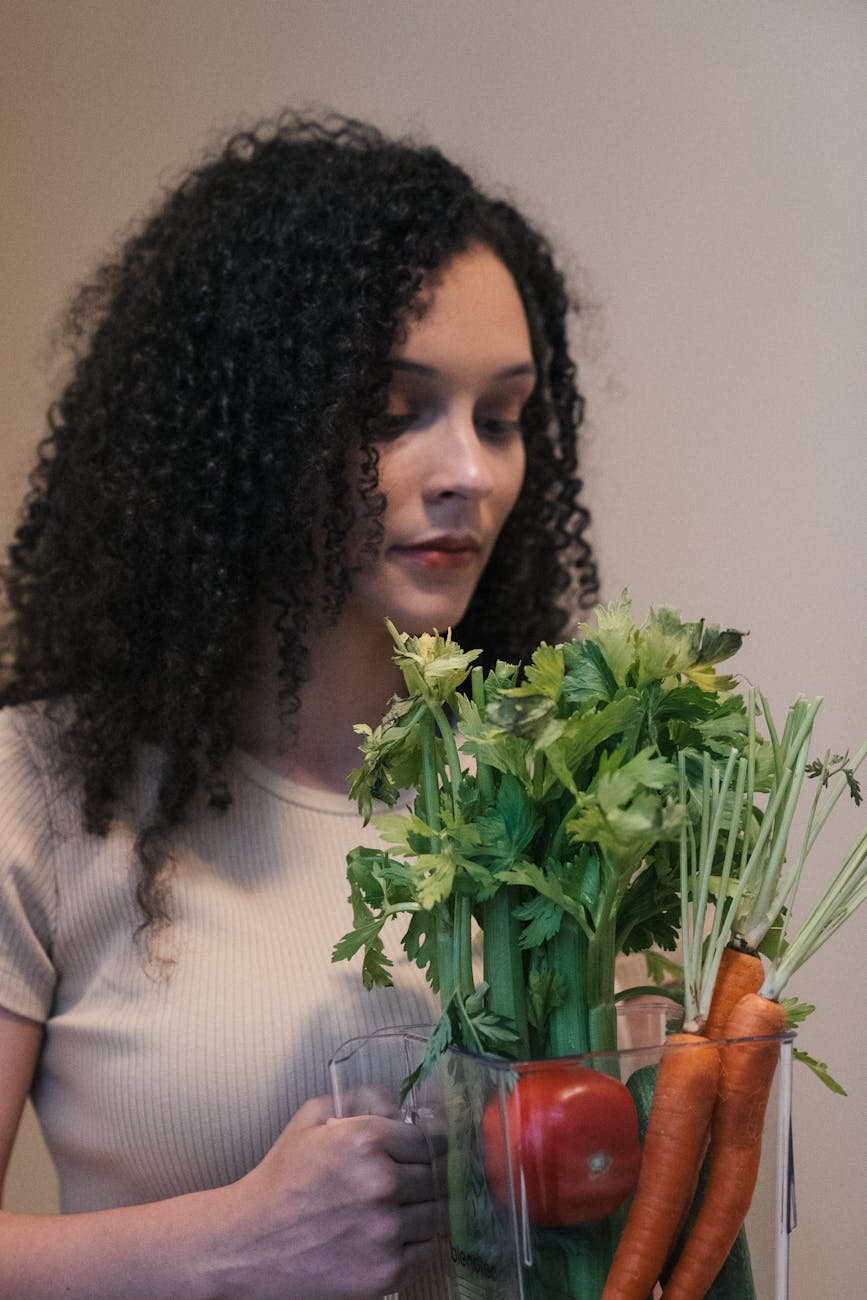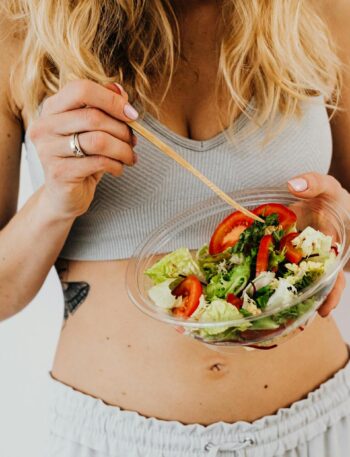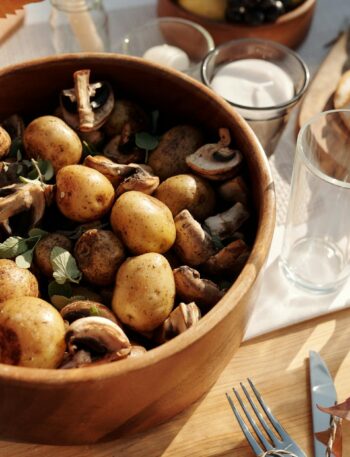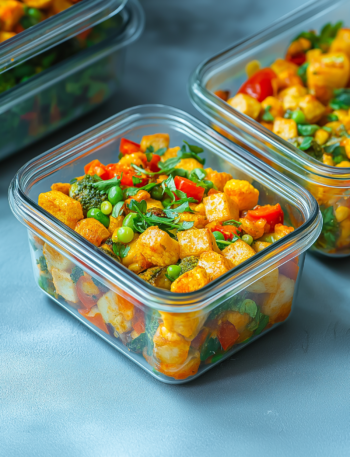Benefits of Vegan Meal Prep
Diving into the perks of vegan meal prep is like unlocking the secret to easier living. It’s perfect for everyone juggling hectic work schedules, fitness buffs yearning for plant power, caring parents, health-aware folks, and students trying to survive on a tight budget. Let’s feast on how it can make life simpler.
Improved Health and Well-being
Embracing a vegan diet is like hitting a health jackpot. It’s suspected to do wonders for both body and mind. Studies are telling us something big: 69% of folks dip their toes into vegan waters for a health boost (thanks Healthline!). Here’s a taste of how it makes life better:
- Cuts down your chances of getting sick with stuff like heart disease, type 2 diabetes, and even cancer. Who doesn’t want that?
- All that fiber gives your digestion a happy dance.
- Your immune system gets a superhero cape.
- Calm the inflammation beast inside.
Got itchy feet for more tips? Head over to our piece about vegan meal prep for health-conscious individuals.
Weight Loss and Body Fat Reduction
Want a smaller waistline? A vegan diet might just be your new best friend. It’s no secret: it helps shed pounds and trim body fat due to fewer calories, happier tummies, and better insulin sass, according to Healthline.
Check out these fun facts:
- People on a plant-fueled diet lost about 5.5 pounds (2.52 kg) more than meat lovers over 18 weeks (Healthline).
- Vegans are 75% less likely to get high blood pressure.
- They’re up to 78% less likely to end up with type 2 diabetes (Healthline).
Got weight goals? Our guides on vegan meal prep for fitness enthusiasts and athletes and vegan meal prep for busy professionals can break it down for ya.
| Benefit | Statistic |
|---|---|
| Weight Loss | 5.5 pounds (2.52 kg) more than non-vegetarians lost in 18 weeks (Healthline) |
| Blood Pressure | 75% less risk of high blood pressure for those plant-eaters (Healthline) |
| Type 2 Diabetes Risk Reduction | Up to a nifty 78% lower risk (Healthline) |
For families looking to keep picky eaters happy, and the money-savvy folks, smart meal planning is a lifesaver. Learn the ropes with our tips on vegan meal prep for parents and families and vegan meal prep for budget-concscious individuals.
Vegan Diet and Disease Prevention
Lower Risk of Chronic Conditions
Choosing a vegan lifestyle can be more than just about saving animals or hugging trees; it’s a ticket to a healthier you. Tossing meat and dairy often slashes your chance of battling with heart disease, type 2 diabetes, cancer, and those sneaky metabolic conditions. Piling up your plate with plants means you’re drowning your body in all the good stuff—it’s like giving your insides a spa day. (Healthline)
Think about these perks:
- Heart Disease: Skipping all that meat means dodging saturated fats and cholesterol; your heart does a little happy dance with lower blood pressure and smoother arteries.
- Type 2 Diabetes: Eating like a rabbit boosts your insulin’s game and helps shrink that waistline, making blood sugar behave.
- Cancer: Fiber from plants is like your belly’s personal janitor, sweeping away toxins and kicking cancer’s butt out the door.
- Metabolic Syndrome: Those plant foods are jam-packed with goodies that fight inflammation, keeping metabolic syndrome at bay.
Craving more? Peek at our vegan meal prep for health-conscious folks. It’s like getting a cheat sheet for healthy eating.
Managing Celiac Disease and Gluten Sensitivity
If gluten’s been bullying your belly, going vegan might just be the peace offering you need. Say so long to gluten—hide it away like socks in winter—and your gut might just send you a thank-you card. Swapping in gluten-free pals like quinoa, rice, and buckwheat makes your tummy happy while keeping the meals delicious.
Skimming gluten and welcoming plants means fewer belly aches and more of those nutrients finding their way where they belong. Grab fruits, veggies, beans, and nuts to load up on essentials without throwing your digestive system into chaos. (Healthline)
Benefits for IBS Symptoms
Living with IBS is no walk in the park, but a vegan twist with a sprinkle of low FODMAP magic can change the game. Those FODMAP doodads might sound funny, but they’re just carbs that can crank up your gut’s temper in people with IBS.
A clever bunch at Monash University figured out that a low FODMAP and vegan plan can put a muzzle on symptoms like gassiness and belly pain (The Conscious Plant Kitchen). Munch on low FODMAP champions like carrots, spinach, and blueberries, and keep troublemakers like onions and garlic outta sight.
Get the scoop on crafting a low FODMAP vegan plan in our meal prep guide for special diets.
By mixing and matching these tricks, whipping up a vegan meal prep that vibes with your health goals, keeps chronic nuisance at bay, or tosses gluten sensitivity to the curb can be a breeze. Tailoring your meals with all this leafy goodness complements anyone—be it a busy workaholic or a fitness junkie.
Nutritional Considerations for Vegans
Eating a vegan diet that keeps you healthy isn’t as tricky as assembling IKEA furniture, but it does need a bit of planning. Here’s the secret sauce to staying on top of your nutrients: protein, vitamin B12, calcium, and vitamin D. Stick with me, and I’ll spill the beans on what you need to know.
Protein and Vitamin B12
Protein does the heavy lifting for muscle repair and keeps your immune system jazzed up. Now, as a vegan, I often get playful with my food choices to ensure I’m muscling up enough protein. Plant buddies like beans, lentils, tofu, tempeh, seitan, and quinoa are your go-to gang for this. Mix ’em up, and you’ll hit your protein goals without breaking a sweat.
Vitamin B12 is your nervous system’s best friend and a must for making those red blood cells. Mostly hanging out in animal products, B12 needs your extra attention as a vegan. Look for it in souped-up plant milks, cereals, and nutritional yeast. If B12 plays hide and seek in your foods, it’s supplement time.
Monitoring Calcium and Vitamin D
Calcium might scream “milk” at you, but there’s plenty beyond the moo. Opt for jazzed-up plant milks, tofu, almonds, sesame seeds, and greens like kale and broccoli. Keep your bones as strong as your willpower, and according to Johns Hopkins Medicine, make calcium your sidekick.
Vitamin D pairs with calcium like peanut butter with jelly, helping it soak up right where it should. Sunlight gives you a good sprinkle of vitamin D, but if you live where it’s cloudy more often than not, latching onto fortified goodies or supplements might be wise.
Here’s a cheat sheet for vegan calcium and vitamin D:
| Nutrient | Sources |
|---|---|
| Calcium | Fortified plant milks, tofu, almonds, sesame seeds, kale, broccoli |
| Vitamin D | Fortified plant milks, mushroom, supplements |
Essential Nutrients for Balance
Balance, folks, not just for yoga but also for your diet. Let’s give some love to iron, omega-3s, and zinc. You find iron in scenes with beans, lentils, quinoa, and those dark leafy heroes. Plant iron isn’t as eager to be absorbed as its animal cousin (Healthline). Pair iron foods with vitamin C-rich munchies like oranges or bell peppers, and you’ll make a power duo.
Here’s the rundown on why vegans need extra iron:
| Group | RDA for Iron (mg/day) | Vegan RDA for Iron (mg/day) |
|---|---|---|
| Males (14-18 years) * | 11 | 19.8 |
| Females (14-18 years)* | 15 | 27 |
| Males (19-50 years) | 8 | 14.4 |
| Females (19-50 years) | 18 | 32.4 |
*Values can fluctuate based on age.
Omega-3s, the heart’s BFFs, pop up in chia, flaxseeds, hemp seeds, and walnuts. And for boosting your immune game with zinc, go nuts—literally—with seeds, beans, and whole grains.
Mix up these power-packed foods and give yourself a nutrient high-five. For more tasty tidbits and meal hacks, check out our takes on vegan meal prep for health-conscious individuals, vegan meal prep for busy professionals, and vegan meal prep for fitness enthusiasts and athletes.
Gluten-Free Vegan Meal Prep
Getting into vegan meal prep, especially if you’re going gluten-free, is like embarking on a delicious adventure. I’m all about creating meals that are not only packed with the good stuff but also hit the spot for specific diet needs.
Meeting Iron Needs
Iron is the unsung hero, especially when you’re juggling a gluten-free vegan lifestyle, and you’re dealing with Celiac Disease or gluten sensitivity. But don’t worry; it’s easier than you think to get that iron pumping through plant-powered bites. Try these tasty options:
- Quinoa – a super seed masquerading as a grain.
- Dark leafy greens like spinach and kale – they’re your iron-packed green warriors.
- Beans and lentils – legumes that mean business!
- Soy goodies like tofu and tempeh – they’ve got your back.
- Iron-fortified gluten-free cereals – because a little help from modern food magic is always welcome.
Remember, mix these with Vitamin C rich foods like bell peppers, oranges, or even juicy tomatoes to supercharge iron uptake!
| Iron Source | Iron Content per 100g |
|---|---|
| Quinoa | 1.5 mg |
| Spinach | 2.7 mg |
| Lentils | 3.3 mg |
| Tofu | 5.4 mg |
| Iron-fortified GF Cereals | Varied |
Want more tips on whipping up vegan meals? Swing by our vegan meal prep for health-conscious individuals page.
Protein Sources and Planning
Protein on a gluten-free vegan path is like building a team of superheroes with different powers. Here’s who’s on the roster:
- Tofu and Tempeh – holding your protein needs down since forever.
- Beans and Lentils – plant powerhouses, no doubt.
- Chickpea Pasta – because, yes, pasta can be part of the plan!
- Whole grains like brown rice and millet – grains that stick with you.
- Nuts and Seeds – crunchy and packed with protein goodness.
Check out these power-packed plant proteins:
| Protein Source | Protein Content per 100g |
|---|---|
| Tofu | 8 g |
| Tempeh | 19 g |
| Lentils | 9 g |
| Chickpea Pasta | 19 g |
| Almonds | 21 g |
Mixing and matching is key. How about a zesty quinoa and lentil salad, sprinkling almonds on top? That’s a meal that doesn’t compromise on taste or nutrition.
If you’re looking to pump things up for your active lifestyle, peek at our vegan meal prep for fitness enthusiasts and athletes.
So, dive right into this tasty journey; gluten-free vegan eats don’t mean skimping on flavor or flair. For more cooking inspiration, hop over to our vegan meal prep for parents and families tips and get that kitchen rocking!
Low FODMAP Vegan Diet
Let’s talk about the Low FODMAP diet, a plan that can really help when IBS symptoms make you feel less than awesome. Sure, it might seem like assembling a puzzle when you go vegan and low FODMAP, but trust me, you can whip up meals that won’t remind you of cardboard while easing those pesky digestive issues.
Customization for IBS Symptoms
I stumbled onto some research from Monash University, which tells us that a low FODMAP vegan diet can calm down those tummy troubles like bloating and stomach pain – the kind that makes you want to stay home with a hot water bottle. To make this work, you need to figure out which foods are best to dodge and which ones can happily sit on your plate.
High FODMAP Foods to Avoid:
- Proteins: Say bye to cashews, pistachios, and red kidney beans.
- Fruits: Tuck apples, pears, and avocados out of sight.
- Vegetables: Stash away cauliflower, garlic, and onions.
- Grains: Kick wheat and rye out of the pantry.
Low FODMAP Alternatives:
- Proteins: Hello, tofu, tempeh, and chickpeas (properly rinsed, of course).
- Fruits: Bring on bananas, grapes, strawberries, and good old pineapples.
- Vegetables: Welcome bell peppers, carrots, and spinach to the party.
- Grains: Quinoa, buckwheat, and rice are your pals now.
Here’s a visual to keep it straight:
| Food Type | High FODMAP Foods | Low FODMAP Alternatives |
|---|---|---|
| Proteins | Cashews, Pistachios | Tofu, Tempeh |
| Fruits | Apple, Pear | Bananas, Grapes |
| Vegetables | Cauliflower, Onions | Bell Peppers, Spinach |
| Grains | Wheat, Rye | Quinoa, Rice |
Need a hand figuring this out? A chat with a FODMAP dietitian can be super helpful. They can help you figure out what exactly your stomach likes and what to give a cold shoulder.
Elimination Phase Guidelines
When you start on the low FODMAP train, you’ll kick things off with what’s called the elimination phase. You swap out all those high FODMAP suspects for lower ones for about 3-6 weeks. Sticking to the plan during this time is key to really understanding what’s sabotaging your gut.
Steps for the Elimination Phase:
- Write down which high FODMAP foods you’re chowing down on regularly.
- Swap them out with the friendly alternatives we mentioned earlier.
- Stick with this game plan for about 3-6 weeks.
Once you’ve played elimination detective, you begin reintroducing high FODMAP foods, one at a time, spread over a few days, keeping a close eye on how you feel. This little test helps expose which foods have been behind the IBS symptoms.
For nerds and lifters, check out our sections on vegan meal prep for busy folks or those into fitness routines for more meal planning tips.
By sticking to these tips and getting comfy with your ingredients, you’ll be able to enjoy meals that won’t just fill you up — they’ll keep those IBS symptoms far, far away.
Iron-Rich Plant Foods
So, you’re living that vegan lifestyle and wondering if you’re getting enough iron? I get it. Whether you’re a busy professional juggling a million things, a fitness buff trying to hit your personal best, or just someone watching their health, making sure you’re getting enough iron is super important.
Plant-Based Iron Sources
Alright, let’s talk about where your iron’s coming from. We’re diving into the magic of non-heme iron, the plant kind. It’s all hidden in everyday goodies like veggies, beans, seeds, and grains. Sure, it’s a bit trickier for the body to absorb compared to the stuff from meat, but when you know where to look, you’re golden.
| Food Item | Iron Content (mg per serving) |
|---|---|
| Iron-fortified cereals | 16.2 |
| Tofu | 3.4 |
| Lentils | 6.6 |
| Spinach (cooked) | 3.6 |
| Quinoa | 2.8 |
| Pumpkin seeds | 4.2 |
| Dark chocolate | 3.3 |
These tasty iron-packed foods fit right into your diet and help keep those iron levels up without going anywhere near animal products. If you need more ideas, swing by our vegan meal prep for busy folks.
Iron Intake Recommendations
How much iron do you actually need? Well, it changes based on who you are and what’s happening in your life. General rule of thumb: if you’re vegan, you might need a bit more because your body’s playing hard to get with non-heme iron.
| Category | RDA for Iron (mg/day) |
|---|---|
| MAAB (Males Assigned at Birth) | 8 – 18 |
| FAAB (Females Assigned at Birth) | 8 – 18 |
| Vegetarians/Vegans | 14.4 – 32.4 |
| Pregnant/Breastfeeding | 9 – 27 |
Give your iron levels a good old check-up and tweak your meals accordingly. Especially if you’re always on the move or you’ve got unique health needs. Wanna get into the nitty-gritty? Check our vegan meal prep guide for fitness enthusiasts.
Enhancing Iron Absorption
Want to really nail this? Get some vitamin C action going. It’s like your iron’s best bud and helps it get into your system better.
Try these combos:
- Lentils and bell peppers, a duo made in food heaven.
- Spinach salad with strawberries tossed in for a sweet twist.
- Broccoli and tofu, an iron boost fit for a meal.
Be cautious, though. Try not to eat iron-rich foods with stuff that holds it back like calcium pills, or enjoy a coffee or tea break a bit later to sidestep those tannins, and don’t stress about the phytates in certain grains and beans too much.
And that’s the scoop! A little planning can totally ensure your vegan diet checks all the boxes. Peek into our tips for vegan meal prep for parents and health-conscious folks to keep things nutritious and delicious.
Vegan Keto Diet Considerations
Understanding Vegan Keto
Let’s chat about meshing two intriguing diet worlds: vegan and keto. Yeah, sounds tricky, right? It’s all about rolling with a low-carb, high-fat lifestyle while booting any animal-based grub off the plate. The result? That’s vegan keto for you! Yup, you can still hit that sweet ketosis spot by munching on good stuff like coconut oil, avocados, seeds, and nuts. Who’d have thought, right? (Healthline).
Here’s how it all shakes out:
| Macronutrient | Recommended Intake |
|---|---|
| Carbohydrates | < 50g/day |
| Protein | Moderate |
| Fat | High |
Health Benefits and Risks
So, why even bother mixing these two? There’s some cool health stuff in the mix but a couple of things to watch out for, too.
-
Weight Loss: Wanna lose a few pounds? Both vegan and keto diets might be your ticket. Some smarty-pants researchers figured out that folks on vegan diet plans lost about 5.5 pounds more than their carnivorous buddies over 18 weeks. And keto? It’s been a game-changer for shedding pounds, especially for kids and teens looking to trim down (Healthline).
-
Disease Prevention: Going vegan keto could be your health superhero! It’s been said that vegans have a way lower risk of high blood pressure and could dodge type 2 diabetes like pro ninjas. Mix that with keto’s awesome blood sugar level checks and you might be cruising towards a healthier lifestyle all around (Healthline).
| Benefit | Vegan | Keto | Vegan Keto |
|---|---|---|---|
| Weight Loss | Yes | Yes | Yes |
| Lower Risk of High BP | Yes | – | Yes |
| Blood Sugar Control | Yes | Yes | Yes |
| Reduced Heart Disease Risk | Yes | Yes | Yes |
- Potential Risks: Watch out, though. Vegan keto ain’t just munching on whatever fits. You gotta keep an eye on your nutrients—get enough protein, vitamin B12, and all that jazz. A bit of extra vigilance goes a long way in avoiding any hiccups (Healthline).
Curious about jumping into vegan meal prep? Peek into vegan meal prep for busy professionals or vegan meal prep for fitness enthusiasts and athletes. And if you’re pinching pennies, vegan meal prep for budget-conscious individuals might just be your new best friend.
Plant-Based Diet Sustainability
Health Benefits and Environmental Impact
Jumping on the plant-based diet train? You’re in for a health boost and a planet-friendly lifestyle. Eating plant-focused—be it vegan or lacto-ovo-vegetarian—means you’re likely to dodge common pitfalls like heart disease, type 2 diabetes, and certain cancers. Why? Because you’ll be munching on loads of natural goodies like fiber, vitamins, and antioxidants instead of junk (PubMed).
On the green front, swapping steak for tofu is a win for Mother Earth. Ditching meat cuts down on nasty emissions, saves water gallons, and demands less land. So, if you’re all about hugging trees and saving whales, adding more greens to your plate can do wonders! If you’re curious about doing right by the earth while eating yummy stuff, check out our guide on vegan meal prep for eco-conscious consumers.
| Less Harm, More Harmony | How It Helps |
|---|---|
| Greenhouse Gases | Lowered |
| Water Usage | Decreased |
| Land Requirements | Minimized |
Global Dietary Trends
Around the globe, more folks are going plant-happy. Though globally only under 10% of folks are hardcore veggies, some places like India see over 20% of their people saying no to meat (PubMed). In the good ol’ USA, about 6% are walking away from meat, with half on team vegan. Even kids are catching on, with 2% eating only plants and 3% opting for non-meat but still eating dairy and eggs.
As more folks join the green table, the plant-based market is exploding! Dairy alternatives are expected to hit $25 billion by 2026, and just in the U.S., people are spending big—like $7 billion big—on foods that didn’t moo, cluck, or oink (PubMed).
Thinking about jumping aboard? There’s meal prep advice for every personality, from the always-busy pro to the gym rat. It’s easy to keep your meal game strong no matter who you are.
| Who’s Munching Plants? | % on Vegan Vibes |
|---|---|
| U.S. Grown-ups | 3% |
| Kids (8-17) | 2% |
| Veg Crowds (India) | 20%+ |
Going plant-fed keeps you feeling good and lends a hand to global eco-efforts. That makes it a doubly smart move—both for you and our spinning ball of blue and green. If you’re up for trying out this tasty revolution, read up on vegan meal prep for health-conscious individuals.





